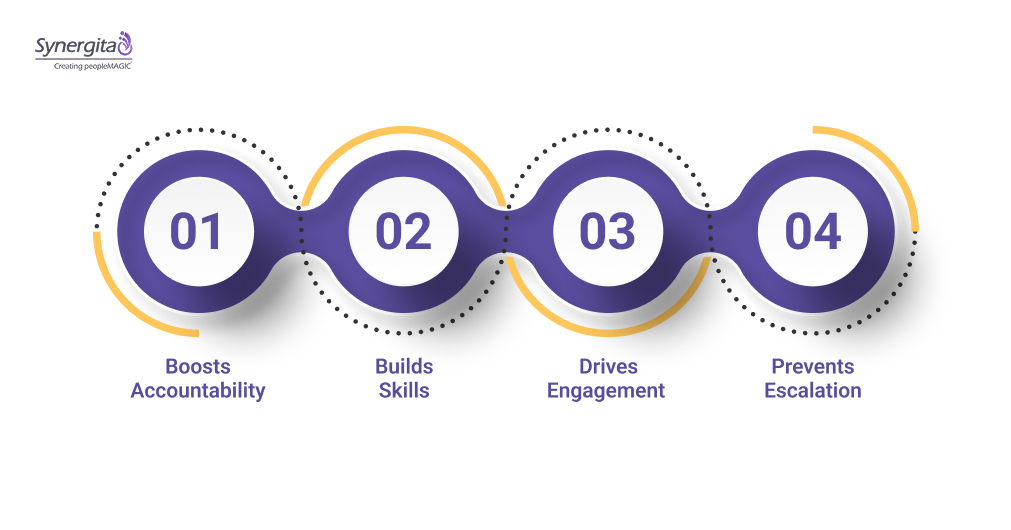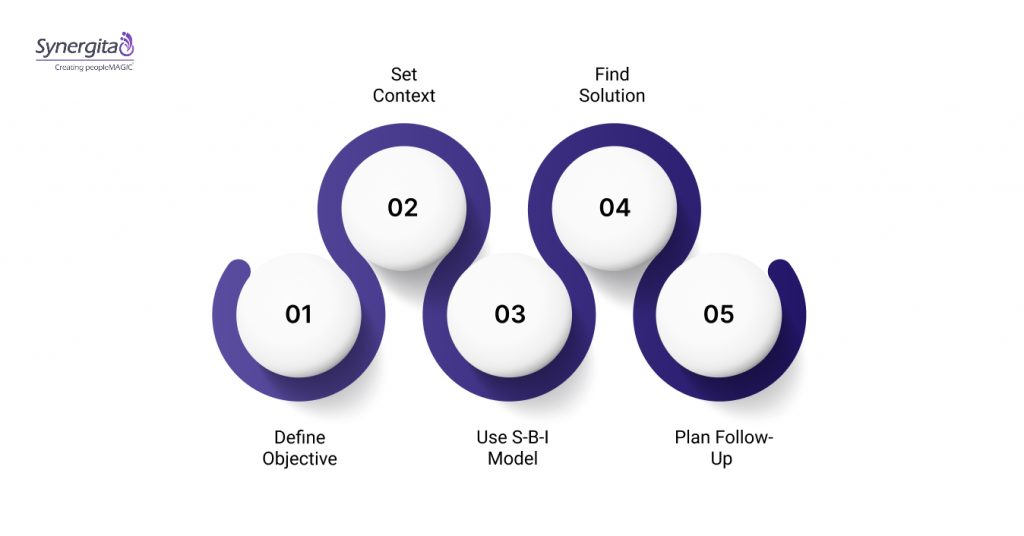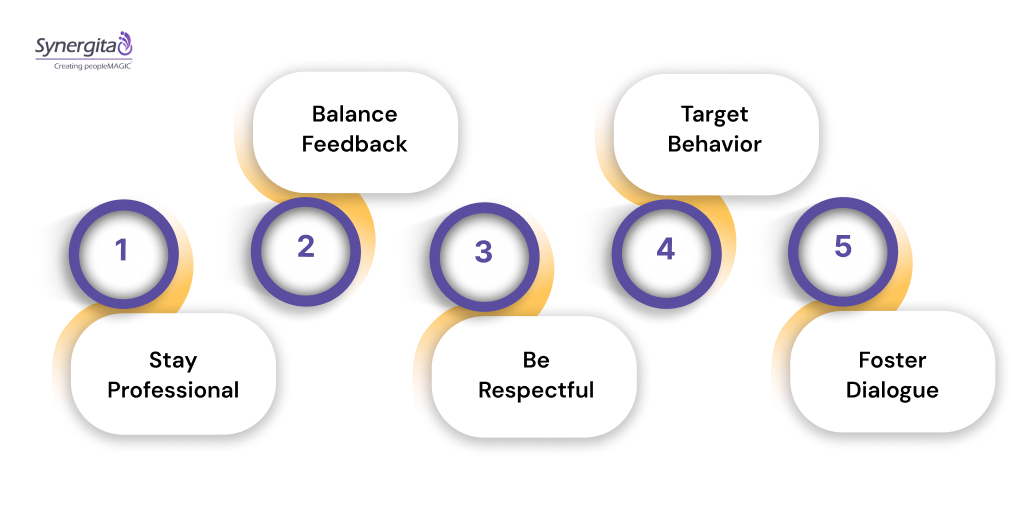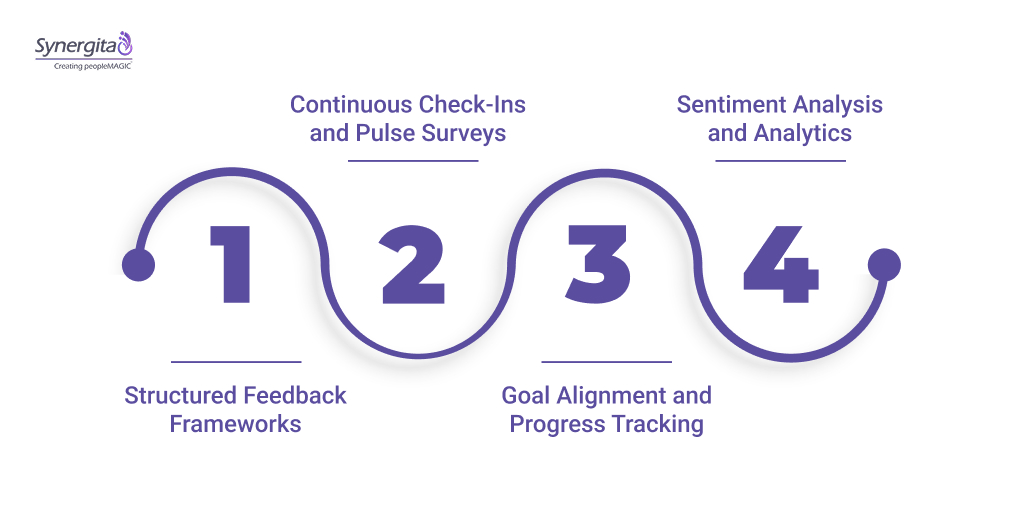You have a high-performing employee who is starting to miss deadlines. Your top salesperson uses an aggressive tone that is alienating clients. You see the problem, but saying nothing feels easier than risking a defensive reaction or damaging a strong working relationship. This avoidance is a leadership tax that quietly erodes performance and morale.
The cost of silence is higher than the discomfort of the conversation. When managers fail to address issues directly, they allow small problems to become entrenched habits. This creates a culture where mediocrity is accepted, top talent becomes frustrated, and your team’s potential remains capped.
The data confirms this: 80% of employees who say they have received meaningful feedback the week before are fully engaged. This guide provides a direct playbook for how to give constructive feedback to employees effectively. You will learn a structured approach that transforms feedback from a dreaded event into a routine driver of growth and performance.
Key takeaways
- Structure Overcomes Discomfort: A disciplined five-step framework: Prepare, Set Context, Apply S-B-I, Collaborate, and Follow Up, transforms difficult conversations into productive dialogues.
- Specificity Drives Improvement: Effective feedback cites observable behaviors and tangible business impacts, moving from vague criticism to actionable guidance for future performance.
- Consistency Builds Trust: Regular feedback integrated into weekly workflows is more effective than sporadic formal reviews, creating a culture of continuous growth and development.
- Objectivity Prevents Defensiveness: The Situation-Behavior-Impact model maintains focus on facts and outcomes, separating the person from the problem being addressed.
- Systematic Execution Enables Scale: Individual manager skill must be supported by platform capabilities that embed feedback into daily operations and ensure organization-wide consistency.
- Documentation Creates Accountability: Recording feedback conversations and action plans establishes a growth trail and ensures both parties remain committed to improvement goals.
What Is Constructive Feedback
Constructive feedback is specific, actionable information aimed at improving performance or correcting behavior. It is not criticism. Criticism focuses on what went wrong; constructive feedback focuses on how to improve. Its purpose is to close the gap between current performance and desired outcomes, making it a tool for professional development.
Effective constructive feedback possesses three key characteristics. It is specific and observable, citing particular behaviors or outcomes rather than generalities. It is actionable, providing clear direction on what to do differently. Finally, it is future-oriented, focused on improvement for next time rather than dwelling on past mistakes.
This type of feedback creates a shared understanding between manager and employee. It transforms subjective opinions into objective discussions about performance, building trust and creating a clear path for growth.
Also read: 15 Effective Feedback Models: Definition and Examples
A clear definition establishes what constructive feedback is, but its strategic value lies in the tangible business outcomes it drives.
Why Is Constructive Feedback Important?

Understanding the definition is one thing; recognizing its operational impact is another. Constructive feedback is the mechanism that converts static job descriptions into dynamic growth paths and aligns individual effort with strategic business outcomes. It is the single most cost-effective performance management tool at your disposal.
Here are the core business reasons why systematic feedback is non-negotiable.
1. Improves Performance and Accountability
Clear, specific feedback directly addresses performance gaps and sets expectations for improvement. It creates a system of ownership where employees understand how their work impacts team objectives. This moves performance management from annual reviews to real-time course correction.
2. Accelerates Skill Development
Feedback provides the roadmap for professional growth by identifying specific skills that need development. It turns everyday tasks into learning opportunities, allowing employees to correct mistakes and build competencies faster. This systematic approach is more effective than waiting for formal training.
3. Increases Engagement and Retention
Employees who receive regular feedback are 3x more likely to be engaged. It demonstrates investment in their growth and provides the clarity needed to succeed. This directly counters the ambiguity and lack of development that often drives top performers to leave.
4. Prevents Escalation of Issues
Addressing concerns early stops minor problems from becoming major performance issues. It maintains team cohesion by resolving conflicts before they affect morale and productivity. This proactive approach saves significant management time and resources later.
Also read: Easy 360 Degree Appraisal Sample You Can Start Using Today
Understanding the ‘why’ creates the imperative for action; the following disciplined framework provides the ‘how’ for consistent execution.
How To Give Constructive Feedback To Employees

Knowing why feedback matters is only half the battle. Execution separates effective leaders from the rest. The following framework replaces anxiety with structure, turning difficult conversations into productive dialogues that drive measurable improvement.
Apply this disciplined five-step process to ensure your feedback is clear, actionable, and results-oriented.
1. Prepare with a Clear Objective
Do not enter a feedback conversation without a precise goal. Your preparation determines whether the discussion will be productive or destructive. Here’s what you should do:
- Define the specific incident: Identify the exact project, meeting, or deliverable where you observed the behavior. Vague references like “your recent attitude” are counterproductive.
- Articulate the business impact: Connect the behavior directly to a team or company objective. For example: “The delay in submitting the report impacted the legal team’s ability to meet their compliance deadline.”
- Formulate a desired outcome: Decide on the specific change you want to see. Your feedback should answer the employee’s unspoken question: “What should I do differently next time?”
2. Set the Right Context
The environment you create either opens the door to receptivity or triggers immediate defensiveness. Follow the steps below:
- Schedule a dedicated, private conversation: Impromptu feedback in a hallway or over a crowded Zoom call signals that the issue is not important enough for a formal discussion.
- Choose a neutral time: Avoid high-stress periods like the end of a quarter or right after a project failure. The goal is a calm, focused dialogue.
- State your positive intent immediately: Begin the conversation by framing your role as a coach. Use a phrase like, “I want to discuss the project debrief because I see a lot of potential in your analytical skills and want to help you present them more effectively.”
3. Apply the S-B-I Model (Situation-Behavior-Impact)
This model forces objectivity by focusing on observable facts, not personal judgments. Here’s how you implement it:
- Situation: Anchor your feedback in a specific time and place. “In the budget planning meeting on Tuesday…”
- Behavior: Describe the observable action without using labels. Instead of “you were uncooperative,” say, “when you dismissed two alternative proposals without asking for supporting data…”
- Impact: Explain the tangible effect of the behavior. “…it created the perception that the decision was already made, which may discourage the team from proposing innovative ideas in the future.”
4. Collaborate on a Solution
Your employee must own the solution for the feedback to result in lasting change. Here’s what you need to know:
- Pause and ask for their perspective: After presenting your S-B-I, transfer the conversation to them. Ask, “What is your view of that situation?” or “How did you perceive the outcome?”
- Develop an action plan together: Co-create the next steps. Ask, “Based on this, what’s one approach we could try for the next client call?” This builds commitment rather than compliance.
- Define a clear success metric: Agree on what improvement looks like. For example: “Success means we get through the next project review with all questions addressed in the pre-read, so the meeting is focused on strategic approval.”
5. Commit to a Follow-Up Plan
A feedback conversation without follow-up is merely a commented event, not a performance management strategy. Below is a detailed breakdown:
- Schedule the next check-in before you adjourn: This demonstrates that the issue and its development are priorities. “Let’s touch base briefly in two weeks to see how the new approach is working.”
- Publicly acknowledge progress: When you see the employee implementing the agreed-upon change, recognize it. This reinforces the desired behavior and shows you are paying attention to their efforts.
- Document the conversation and plan: Use your performance management system to record the key points and action items. This creates a record of growth and holds both parties accountable.
A theoretical framework provides the structure, but its practical application becomes clear through real-world scenarios.
Also read: The Strategic Purpose of Performance Management: Boost Growth & Engagement
Examples of Constructive Feedback
The framework provides the structure, but a real-world application requires nuance. These examples translate the S-B-I model into actionable language for common management challenges, demonstrating how to address specific behaviors while maintaining a developmental focus.
Apply these templates to your most frequent feedback scenarios, adapting them to your specific context.
Missing Project Deadlines
Address chronic lateness without attacking character. Focus on the process, not the person.
“On the Q3 dashboard project, the final report was submitted two days past the deadline. This created a chain reaction, delaying the marketing team’s campaign launch by 48 hours. For the next project, let’s build in a 48-hour buffer for your initial draft and schedule two check-in points before the final due date.”
Overly Critical in Team Meetings
Correct counterproductive communication that stifles collaboration.
“During the brainstorming session yesterday, when you described three separate proposals as ‘unworkable’ without suggesting alternatives, I noticed several team members stopped contributing ideas. This reduces the diversity of solutions we can consider. In the next meeting, practice using the ‘yes, and…’ technique to build on others’ suggestions before critiquing them.”
Inadequate Client Documentation
Improve work quality by linking documentation to tangible business risks.
“Regarding the client onboarding for ABC Corp, the process checklist in the CRM was only 50% complete. This means the account team lacks visibility into completed steps, which increases the risk of missing a critical handoff and damaging client trust. Let’s block 30 minutes to create a template together, and I will review your first two entries.”
Resistant to Process Changes
Guide employees through transitions by emphasizing the strategic ‘why’.
“When the new reporting workflow was introduced last week, you continued to use the legacy system for three days after the cutoff. This created duplicate entries that the data team had to reconcile, costing several hours. I need you to adopt new mandates within 24 hours of rollout. Let’s walk through the business rationale so you understand the downstream impact of delay.”
Ineffective Delegation
Help managers scale their impact by developing their team’s capabilities.
“On the product launch, you personally handled all the minor copy edits instead of assigning them to your junior associate. As a result, you became a bottleneck, and your report missed out on a key developmental opportunity. For the next launch, you will delegate all first-round revisions and focus only on final approval.”
While examples provide a template for what to say, mastering the delivery requires attention to the nuanced how and when.
Also read: How to Handle a Performance Review Effectively
Tips for Giving Constructive Feedback

Mastering the mechanics of feedback is not enough. The delivery and ongoing practice determine whether your message catalyzes growth or creates resistance. These tactical refinements elevate your approach from technically correct to genuinely effective.
Integrate these principles into your management practice to build a culture of continuous improvement.
Maintain a Calm, Professional Tone
Your emotional state directly influences the conversation’s outcome. If you are frustrated, delay the discussion. A neutral tone keeps the focus on the issue, not your reaction. Frame the conversation around shared goals, not personal disapproval.
Balance Criticism with Recognition
Feedback should not be exclusively corrective. Adopt a 3:1 ratio of positive to constructive comments. Acknowledge what the employee does well before addressing gaps. This balance demonstrates you see their whole contribution, increasing receptivity to developmental points.
Be Direct but Not Abrasive
Avoid softening your message with excessive qualifiers, which can create confusion. State the issue clearly using factual observations. Simultaneously, eliminate judgmental language. The goal is clarity, not criticism for its own sake.
Focus on the Behavior, Not the Person
Separate the individual from the action. Critique the work product, the missed deadline, or the communication style, not their character or intentions. This prevents defensiveness and keeps the conversation solution-oriented.
Make It a Continuous Dialogue
Shift from sporadic “feedback events” to an integrated practice. Provide observations promptly, when the context is fresh. Use weekly check-ins for minor adjustments, reserving formal sessions for larger patterns. This normalizes feedback as part of the work rhythm, reducing anxiety.
Individual skill is foundational, but scaling these practices across an organization requires a systematic approach that embeds feedback into your operational rhythm.
Also read: How to Perform Effective Talent Reviews in 2025
Enable Consistent Feedback With Synergita
Even with a clear framework and practical tips, many organizations struggle to make constructive feedback a consistent, embedded practice. The obstacles are often systemic: infrequent feedback cycles, lack of managerial accountability, and no centralized system to track conversations and outcomes. This leads to ad-hoc coaching that fails to drive long-term behavioral change.
Synergita transforms feedback from a managerial burden into a streamlined, strategic process. Our integrated performance platform provides the structure and tools necessary to make continuous, constructive feedback a natural part of your workflow, ensuring it is delivered, documented, and acted upon consistently across the organization.
The platform directly addresses these challenges with specific features:

- Structured Feedback Frameworks: Guide managers to deliver balanced, actionable feedback using built-in templates and the S-B-I model, ensuring consistency and quality in every conversation.
- Continuous Check-Ins and Pulse Surveys: Move beyond the annual review with tools for scheduled one-on-ones and real-time feedback, creating a culture of ongoing dialogue and course correction.
- Goal Alignment and Progress Tracking: Connect feedback directly to individual goals and development plans, providing clear context and making it relevant to the employee’s growth and objectives.
- Sentiment Analysis and Analytics: Use AI-powered insights to gauge the tone of feedback and identify coaching gaps across teams, enabling HR to provide targeted support where it’s needed most.
This integrated approach ensures that constructive feedback evolves from a well-intentioned concept into a measurable driver of performance and engagement.
A platform provides the necessary infrastructure, but the ultimate value is realized when it transforms feedback from a managerial task into a strategic advantage.
Conclusion
Mastering constructive feedback is not a soft skill; it is a critical leadership discipline that directly impacts performance, retention, and engagement. The framework and examples provided give you an actionable playbook to move from avoiding difficult conversations to leading them with confidence and purpose. This shifts your role from a passive observer of performance issues to an active coach driving measurable improvement.
However, consistent execution across an entire management team requires more than individual skill; it demands a system that embeds these principles into daily operations. Synergita provides that infrastructure, turning the art of feedback into a scalable, trackable business process that connects directly to growth and goals.
To see how a structured platform can transform feedback from a managerial challenge into a strategic advantage for your organization, schedule a personalized demonstration.
FAQs
Q. What’s the difference between constructive feedback and criticism?
Constructive feedback focuses on specific, observable behaviors and provides actionable steps for improvement. Criticism typically involves personal judgments and focuses on what went wrong without offering solutions. The key distinction is that constructive feedback is future-oriented and developmental, while criticism is often past-focused and demotivating.
Q. How do you give constructive feedback to a defensive employee?
Begin by stating your positive intent and emphasizing shared goals. Use the S-B-I model to maintain objectivity and focus on facts rather than personal attributes. Ask open-ended questions to understand their perspective and frame the conversation as problem-solving rather than criticism. Schedule the discussion when both parties are calm and not under immediate pressure.
Q. What is the best timing for delivering constructive feedback?
Provide feedback as close to the observed behavior as possible, while ensuring privacy and adequate time for discussion. Avoid high-stress moments or end-of-day fatigue. For complex issues, schedule a dedicated meeting within 24-48 hours. The goal is to address issues while the context remains fresh, but emotions have stabilized.
Q. How often should managers give constructive feedback?
Incorporate constructive feedback into regular weekly check-ins rather than saving it for formal reviews. Research shows employees prefer immediate, ongoing feedback – 43% of highly engaged employees receive feedback at least once a week. Balance constructive points with positive recognition to maintain motivation and trust.
Q. Can you give constructive feedback to senior team members?
Yes, but approach it with additional preparation and respect for their experience. Focus on business impact rather than personal style, use data to support your observations, and position your feedback as seeking their perspective on improving outcomes. Frame it as collaborative problem-solving rather than directive feedback.


